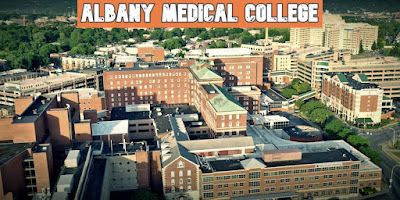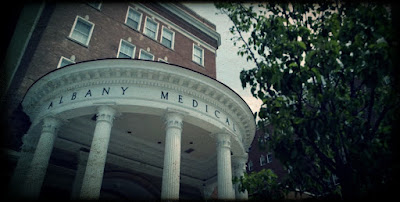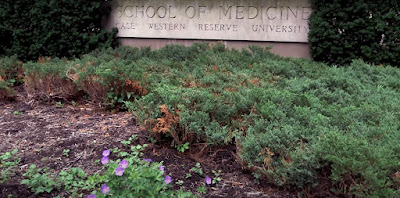Albany Medical College: GPA and MCAT scores, Clinical Years and Social Life
Founded in 1839, Albany Medical College (Albany Med) is one of the nation's oldest private medical colleges. The school prides itself on providing rigorous medical training in an intimate and collegial environment that fosters humane values. However, Albany Med is no blue-plate special at $29,330 per year.
Albany, the state capital, is located in upstate New York. As most students attest, the winters are too long, springs too rainy, and summers too short. While not Alaska, Albany's winters are not for the weak of heart.
The Admissions Committee at Albany Med strives to select 124 diverse, well-rounded individuals. Admission is not based solely on MCAT scores. Instead, strong consideration is given to prior academic performance, the personal essay, letters of recommendation, and interviews. Typically, selected candidates are interviewed by two faculty members and one fourth-year student. At Albany Med, the interview is an attempt to learn more about the candidate's interests, not an oral e.xamination on the finer points of the Krebs cycle. The mean undergraduate GPA and MCAT scores for the class of 2019 were 3.51 and 514, respectively.(Changes every year)
Of the 124 students Albany Med matriculates, approximately forty are from combined undergraduate- M.D. degree programs with RPI, Union College, and Siena College. While New York State residents comprise roughly 40 percent of the student body, Californians are second at 20 percent. In 1998, 50 percent of the incoming students were women. Minority students account for approximately 30 percent of the class. Albany Med's Office of Minority Affairs actively recruits well qualified underrepresented students.
Students at Albany Med range in age from 19 to 40. Student backgrounds are both diverse and impressive. The student body includes mothers, fathers, professional musicians, lawyers, Ph.D.'s, pharmacologists, and public health administrators. Students at Albany Med are as intelligent as they are diverse, supportive, caring, and actively involved in the community.
For many, the first two years are the most grueling. The days are long (sitting in lecture halls from 9 a.m. to 5 p.m.), the material highly detailed (some days dedicated solely to zinc fingers), and patient contact scarce. The college is revising its curriculum to include more patient contact during the preclinical years. The class of 2003 was the first to have clinical skills introduced during the first year. Still, most of the clinical exposure during the first year comes from patient presentations. Patients are brought into the lecture hall, and they discuss the symptoms that lead them to seek medical attention.
During second year, students are divided into groups of four and assigned a clinical preceptor. The students meet with their preceptor once or twice a month during the first half of the year to learn a specific aspect of the physical exam (i.e., the abdominal exam). Once all systems have been covered, the students perform history and physical exams (H&P) on actual patients in the hospital under the supervision of their preceptor. The preceptor reviews each H&P to identify weaknesses/strengths. In addition, students' clinical skills are tested using standardized or, as students call them, fake patients. Basically, students perform a history and physical exam on healthy people pretending to have some disease not the highhght of our medical education, to say the least. Classes end in early May, which gives students three weeks off to study for the USMLE Step I.
Between the second and third years, each student is assigned to a two-week Orientation Clerkship designed to instruct students on the skills necessary to begin third year. During this time, students are instructed on how to start IVs, draw blood, apply casts, suture, perform CPR, and write progress notes. Once again, the fake patients rear their heads so that students can practice H&Ps before struggling with real patients.
Most students complain about suchthings as long days, little clinical exposure, and that preceptors are fourth-year medical students rather than attending physicians. However, students also have a number of perks, including dedicated faculty members and a student body that fosters cooperation and supports each other.
Grading during both third and fourth years is based on clinical performance (clinical skills and judgment, knowledge, interpersonal skills, personal attributes, and dedication). Residents and attendings (i.e., those with whom you work) complete the evaluations. Grades range from Honors to Unsatisfactory.
While all third-year rotations must be completed at AMCH or one of its affihates, fourth year offers more freedom. Fourth years consists of ten periods (one of which is vacation), each four weeks long. Five are required rotations (intensive care, general surgery acting internship, primary care acting internship, neurology, and emergency medicine). Special arrangements must be made to do required rotations away from AMCH. Having five required clerkships is a major source of contention, as most schools have fewer or none.
Clinical exposure is reasonably broad, as AMCH draws from an area of more than 2 million people. In addition to the Level 1 trauma center and Level III perinatal care center, AMCH is a state-designated regional AIDS treatment center, houses a Children's Hospital, and maintains a Bone Marrow Transplantation Program. Most criticism regarding clinical training is not the lack of diversit)' but the lack of teaching by many residents. The reality of the situation is that most residents just do not have the time; they are overburdened with hard core work. Program directors have responded to this by designating certain times for teaching. Another problem that students frequently voice is that they do not get to perform many procedures. Very few students can say that they have put in IVs or Foley catheters or have much experience drawing blood. Gripes concerning clinical years include too many required clerkships and not enough experience performing procedures. A perk about the clinical years includes working with highly trained and nationally recognized physicians and researchers, supportive/knowledgeable staff that helps coordinate away rotations, and an Academic Affairs Office that is extremely knowledgeable and supportive regarding the residency match.
Since it is not New York City, prices are reasonable and crime minimal. Most students live within walking distance of the college. Rents range from $300-5550 for one-bedroom apartments. The college does offer student housing on a limited basis (eighty-four students per year). Each floor is divided into four suites of six people. Each suite has a microwave and refrigerator, but there is only one stove per floor. The rooms are rather small students can squeeze a twin mattress and desk in one but affordable. Housing and roommate listings are available in the Student Affairs Office.
Web: http://www.amc.edu/
Albany, the state capital, is located in upstate New York. As most students attest, the winters are too long, springs too rainy, and summers too short. While not Alaska, Albany's winters are not for the weak of heart.
The Admissions Committee at Albany Med strives to select 124 diverse, well-rounded individuals. Admission is not based solely on MCAT scores. Instead, strong consideration is given to prior academic performance, the personal essay, letters of recommendation, and interviews. Typically, selected candidates are interviewed by two faculty members and one fourth-year student. At Albany Med, the interview is an attempt to learn more about the candidate's interests, not an oral e.xamination on the finer points of the Krebs cycle. The mean undergraduate GPA and MCAT scores for the class of 2019 were 3.51 and 514, respectively.(Changes every year)
Of the 124 students Albany Med matriculates, approximately forty are from combined undergraduate- M.D. degree programs with RPI, Union College, and Siena College. While New York State residents comprise roughly 40 percent of the student body, Californians are second at 20 percent. In 1998, 50 percent of the incoming students were women. Minority students account for approximately 30 percent of the class. Albany Med's Office of Minority Affairs actively recruits well qualified underrepresented students.
Students at Albany Med range in age from 19 to 40. Student backgrounds are both diverse and impressive. The student body includes mothers, fathers, professional musicians, lawyers, Ph.D.'s, pharmacologists, and public health administrators. Students at Albany Med are as intelligent as they are diverse, supportive, caring, and actively involved in the community.
Preclinical Years
The first two years are organized into conceptual or organ system modules. During the first year, students learn normal physiology, histology, and anatomy, while the second year concentrates on the abnormal, the pathophysiolog)' of disease processes. Grading is based on a modified Pass/Fail system. After each theme, a multiple-choice exam is administered. The grade of that exam determines a student's grade for the theme. Grades range from Honors to Unsatisfactory.For many, the first two years are the most grueling. The days are long (sitting in lecture halls from 9 a.m. to 5 p.m.), the material highly detailed (some days dedicated solely to zinc fingers), and patient contact scarce. The college is revising its curriculum to include more patient contact during the preclinical years. The class of 2003 was the first to have clinical skills introduced during the first year. Still, most of the clinical exposure during the first year comes from patient presentations. Patients are brought into the lecture hall, and they discuss the symptoms that lead them to seek medical attention.
During second year, students are divided into groups of four and assigned a clinical preceptor. The students meet with their preceptor once or twice a month during the first half of the year to learn a specific aspect of the physical exam (i.e., the abdominal exam). Once all systems have been covered, the students perform history and physical exams (H&P) on actual patients in the hospital under the supervision of their preceptor. The preceptor reviews each H&P to identify weaknesses/strengths. In addition, students' clinical skills are tested using standardized or, as students call them, fake patients. Basically, students perform a history and physical exam on healthy people pretending to have some disease not the highhght of our medical education, to say the least. Classes end in early May, which gives students three weeks off to study for the USMLE Step I.
Between the second and third years, each student is assigned to a two-week Orientation Clerkship designed to instruct students on the skills necessary to begin third year. During this time, students are instructed on how to start IVs, draw blood, apply casts, suture, perform CPR, and write progress notes. Once again, the fake patients rear their heads so that students can practice H&Ps before struggling with real patients.
Most students complain about suchthings as long days, little clinical exposure, and that preceptors are fourth-year medical students rather than attending physicians. However, students also have a number of perks, including dedicated faculty members and a student body that fosters cooperation and supports each other.
Clinical Years
Just when you don't think you can take one more minute of sitting in the hard plastic swivel chairs, SMILE, it's third year! Time to put on that white coat and pretend that you really know how to use that ophthalmoscope. All students rotate through internal medicine, pediatrics, family practice, surgery obstetrics/gynecology, and psychiatr)', but in different chronology. Clinical rotations are divided among Albany Medical College Hospital (AMCH) and the College's affiliates Stratton Veterans Affairs Medical Center, St. Peter's Hospital, Ellis Hospital, and Capital District Psychiatric Center. Most students spend the majority of their rotations at Albany Medical Center. Adjacent to the medical college, AMCH is one of the largest general hospitals in New York. It is the only academic health science center in twenty-five counties of eastern New York and western New England. A Level I regional trauma center. Level III regional perinatal care center, and recipient of Top 100 Hospitals, AMCH houses 651 beds and averages 23,000 admissions annually.Grading during both third and fourth years is based on clinical performance (clinical skills and judgment, knowledge, interpersonal skills, personal attributes, and dedication). Residents and attendings (i.e., those with whom you work) complete the evaluations. Grades range from Honors to Unsatisfactory.
While all third-year rotations must be completed at AMCH or one of its affihates, fourth year offers more freedom. Fourth years consists of ten periods (one of which is vacation), each four weeks long. Five are required rotations (intensive care, general surgery acting internship, primary care acting internship, neurology, and emergency medicine). Special arrangements must be made to do required rotations away from AMCH. Having five required clerkships is a major source of contention, as most schools have fewer or none.
Clinical exposure is reasonably broad, as AMCH draws from an area of more than 2 million people. In addition to the Level 1 trauma center and Level III perinatal care center, AMCH is a state-designated regional AIDS treatment center, houses a Children's Hospital, and maintains a Bone Marrow Transplantation Program. Most criticism regarding clinical training is not the lack of diversit)' but the lack of teaching by many residents. The reality of the situation is that most residents just do not have the time; they are overburdened with hard core work. Program directors have responded to this by designating certain times for teaching. Another problem that students frequently voice is that they do not get to perform many procedures. Very few students can say that they have put in IVs or Foley catheters or have much experience drawing blood. Gripes concerning clinical years include too many required clerkships and not enough experience performing procedures. A perk about the clinical years includes working with highly trained and nationally recognized physicians and researchers, supportive/knowledgeable staff that helps coordinate away rotations, and an Academic Affairs Office that is extremely knowledgeable and supportive regarding the residency match.
Advancing Medical Education Through Scholarships at Albany Medical College
Social Life
Situated in the Capital Region, Albany's geographic claim to fame is that it is 3 hours from both Boston and New York City. Initially, most students who are new to Albany complain that there's not a whole lot to do. However, these students quickly realize that Albany has enough to occupy their free time. While it is not New York City, Albany does have its share of restaurants and nightlife, bars, clubs, and theaters. Also, there are numerous shopping malls close by. For outdoor recreation, the nearby Catskill and Adirondack Mountains are ideal for hiking, camping, and skiing. Lake George, roughly an hour north, also has some great trails, beaches, and parasailing. During the summer, Saratoga, about 30 minutes away, is home to the SPAC concert series, Newport lazz Festival, and New York City Ballet.Since it is not New York City, prices are reasonable and crime minimal. Most students live within walking distance of the college. Rents range from $300-5550 for one-bedroom apartments. The college does offer student housing on a limited basis (eighty-four students per year). Each floor is divided into four suites of six people. Each suite has a microwave and refrigerator, but there is only one stove per floor. The rooms are rather small students can squeeze a twin mattress and desk in one but affordable. Housing and roommate listings are available in the Student Affairs Office.
Albany Medical College-Internal Medicine Residency
Students who graduate from Albany Medical College leave with a solid medical education, lifelong friends, and substantial debt.Web: http://www.amc.edu/






















Comments
Post a Comment